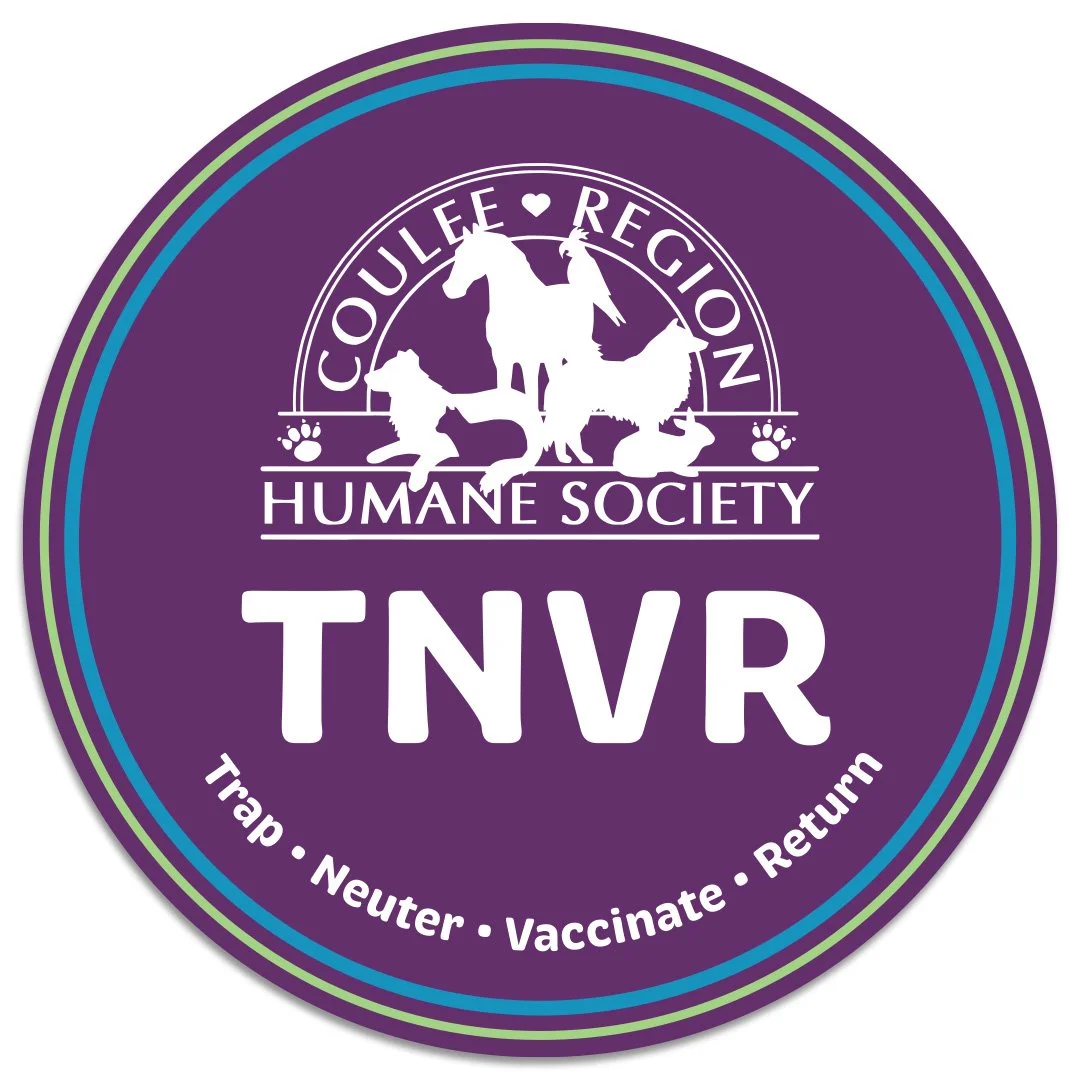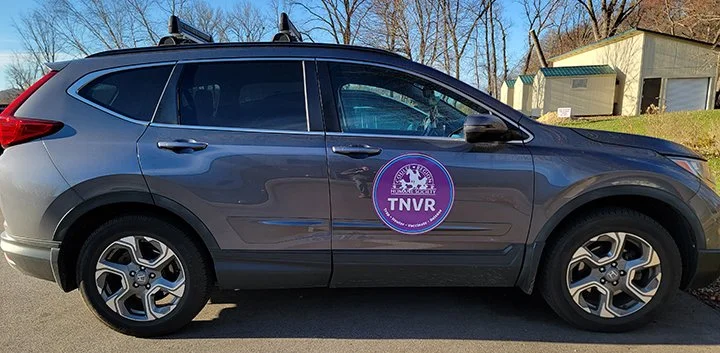county of La Crosse TNVR Program
Trap, Neuter, Return (TNR) is now County-Wide!
We’re excited to share that the Trap, Neuter, Return program is now active throughout all of La Crosse County, not just within city limits!
Here’s how it works: community cats are humanely trapped, spayed or neutered, vaccinated, and eartipped (that’s the universal sign that a cat has been sterilized through a TNR program). Once they’ve recovered, they’re returned to the outdoor homes they know and love, where they can live out their lives safely and without contributing to overpopulation.
At the shelter, we’re proud to play a key role in this life-saving program. When you see one of our team members releasing cats, look for our big purple sign or blue vest, you’ll know it’s part of our ongoing TNR work.
This program makes a huge difference in controlling feral cat populations and improving the lives of outdoor cats. We’re so thankful to our compassionate community members who are helping by trapping and bringing these cats to us. Together, we’re saving lives!
-
Community Cat - A blanket term to describe any cat that is free roaming and unowned which may be cared for by one or more persons who are known or unknown. They are generally feral (not socialized or friendly towards humans) however they do range sociability.
TNVR - Short for Trap, Neuter, Vaccinate, Release, is the process of spaying/neutering, vaccinating, and ear-tipping a cat that cannot be placed in an indoor setting to be released back to the location they came from.
Community Cat Caretaker (Caretaker) - Any person (known or unknown) who provides voluntary care of a community cat or community cat colony, including, but not limited to providing food, water, and shelter. Caretakers may also assist with the TNVR process.
Ear-Tipping - The process of surgically removing the tip of a cat’s ear (thus making them “ear-tipped) as a means to visually designate the cat’s alter status –without the need of a physical examination - as being spayed or neutered.
Feral Cat - An unsocialized outdoor cat that has either never been socialized by people or humane contact has diminished over enough time that the cat is no longer accustomed to it and therefore cannot be safely handled.
Identification - Anything that can be used to either track down the owner of an animal or can be used to reasonably deduce that the animal is owned including but not limited to: rabies tag, license tag, tag and or collar with owner’s contact information on it, microchip, and/or the presence of a collar, harness or sweater.
Stray Cat - A cat that has been socialized with humans at some point in their life that is roaming at large, this can include lost cats, cats that are allowed to free roam by their owners (aka indoor-outdoor), and cats that have been abandoned by their owners and are homeless.
-
Community cats live outdoors and are cared for by Community Caretakers. Like all animals, community cats settle where food and shelter are available, and they are naturally skilled at finding these on their own. If not altered they will also continue to procreate, which is where TNVR helps reduce the population over time.
-
Those that are under-socialized (feral) can’t live indoors with people, and are therefore unadoptable. Trap-Neuter-Vaccinate-Return (TNVR) is the humane, effective, and mainstream approach to addressing community cat populations.
In a TNVR program, feral/under-socialized community cats are humanely trapped, brought to a veterinarian to be spayed or neutered, vaccinated, eartipped (the universal sign that a cat is part of a TNR program), and then returned to their outdoor homes. Kittens less than 8 weeks old can be socialized and then adopted. Adult cats who are socialized can be adopted.
TNR improves cats’ lives and provides an effective, humane, and collaborative way for communities to coexist with cats.
-
The Vacuum Effect has been documented worldwide in many species, including community cats.
Animal control’s typical approach has been to catch and kill community cats. While this may temporarily reduce the number of community cats in a given area, it is ultimately counterproductive, as the population of cats rebounds. Other cats move into the newly available territory and continue to breed—this phenomenon is called the Vacuum Effect. It’s why catch and kill doesn’t work. TNR is the only effective and humane approach to address community cat populations.
Learn more at alleycat.org/VacuumEffect
-
Stray Cat Characteristics
Any cat that is immediately friendly, social, talkative, and/or can be handled is a stray cat.
May be vocal, meow, purr or “answer” to your voice.
May make eye contact.
May walk and move like a house cat with tail up.
More likely to be diurnal (seen during the day).
May tolerate touching with an object.
May come to the front of the cage.
May rub against the cage in a friendly manner.
May investigate food placed near the cage.
Can hiss or growl to show anxiety.
Feral Cat Characteristics
Won’t meow or purr.
Cannot be touched.
More likely to be nocturnal.
Will likely stay in the back of the cage and retreat as far back as possible. If jolted or frightened, may shake, rattle or climb the cage and could become injured banging into the cage.
May crawl, crouch, stay low to the ground/floor, and protect body with tail.
Will likely ignore all people and food when offered.
Will likely avoid eye contact.
Will be aggressive and lash out if threatened or cornered (signs of aggression include ears back and eyes dilated).
-
Cats that are ear-tipped with identification - Attempts should be made to return to owner in field. In the event that Animal Control is not able to get a hold of the owner the cat should then be brought to CRHS where further attempts to reunite with the owner will be made. In the event the cat is not reclaimed a path will be determined.
Feral cats that are not ear tipped - Should be brought to CRHS for TNVR.
Friendly cats without identification (regardless of ear-tipped status) - Should be brought to CRHS to determine alternate placement in the event no owner comes forward to reclaim.
Feral cats that are ear tipped with no identification - Should not be brought to CRHS and should instead be released in the same area they were found.
Cats that have significant medical concerns (illness or injury) - Should be brought to CRHS.
-
Problem: Cats get in your trash. Reason: Cats are looking for food.
1. Secure your trash can with a tight lid or bungee cords. This will protect your trash from wildlife as well.
2. Find out if neighbors are feeding the cats. If they are, make sure they are following best practices. Learn more at alleycat.org/BestPractices.
3. Consider feeding the cats yourself if you find no regular caregiver. Feeding cats using best practices will help ensure they don’t get hungry enough to get into trash.
Note: Feeding stations provide cats with a designated area to eat. Find tips for building or buying feeding stations at alleycat.org/FeedingStations.
Problem: Cats sleep under your porch or in your shed. Reason: The cats are looking for a dry, warm shelter away from the elements.
1. Block or seal the area where the cats enter with chicken wire or lattice, but only once you are absolutely certain no cats or kittens are inside.
2. Provide covered shelter. Or, if the cats have a caregiver, ask the caregiver to provide covered shelter. Shelters should be placed in quiet areas away from traffic.
Find tips to build or buy shelters at alleycat.org/ShelterGallery.
Problem: Cats lounge in your yard or porch, or on your car. Reason: Cats tend to remain close to their food source.
1. Apply fragrances that deter cats around the edges of your yard, the tops of fences, and on any favorite digging areas or plants.
2. Install an ultrasonic deterrent or a motion-activated sprinkler. You can find humane deterrent products at garden supply stores.
3. Use a car cover or place carpet runners on top of your car to avoid paw prints.
4. Shift the cats’ food source to a less central location, where you won’t mind if they hang out.
Problem: Feeding cats attracts insects and wildlife. Reason: Leaving food out for too long can attract other animals.
1. Feed the cats at the same time and location each day. They should be given only enough food to finish in one sitting. If another person is caring for the cats, ask them to follow these guidelines.
2. Keep the feeding area neat and free of leftover food and trash.
For more colony care guidelines, visit alleycat.org/ColonyCare.
Problem: Cats dig in your garden. Reason: It is a cat’s natural instinct to dig in soft or loose soil, moss, mulch, or sand.
1. Put out fragrances that keep cats away. Scatter fresh orange or lemon peels. Wet coffee grounds, and metal pans filled with vinegar also deter cats.
2. Add the herb rue to gardens to keep cats out, or sprinkle dried rue over gardens or landscaping.
3. Use plastic carpet runners, spike-side up, covered lightly in soil. They can be found at hardware or office supply stores. You can also set chicken wire firmly into the dirt (roll sharp edges under), arrange branches or sticks in a lattice pattern, or put wooden or plastic fencing over soil.
4. Get the Cat Scat Mat, a non-chemical cat deterrent consisting of plastic mats that are cut into smaller pieces and pressed into the soil. Each mat has flexible plastic spikes that are harmless to cats and other animals but discourage digging.
5. Get motion-activated sprinklers.
6. Cover exposed ground in flower beds with large river rocks to prevent cats from digging. Rocks have the added benefit of deterring weeds.
7. Make an outdoor litter box away from your garden by tilling the soil or placing sand in an out-of-the-way spot in your yard. Clean the area frequently.
Problem: Cats are yowling, fighting, spraying, roaming, and having kittens. Reason: These are mating behaviors. Once the cats are spayed or neutered, these behaviors will stop.
1. Conduct Trap-Neuter-Vaccinate-Return (TNVR) if local ordinances allow. TNVR stops mating behaviors and ensures no new kittens are born.
2. If cats are on your property and you are willing for them to remain there you just wish for the behavior to stop and to reduce the number of cats over time you may be able to receive assistance from Coulee Region Meow Mission.
Coulee Region Meow Mission is a TNVR group that could assist with TNVR in municipalities that allow it or provide assistance in getting the colony on your property altered and reduced over time. You can email them at crmminfo@gmail.com.




